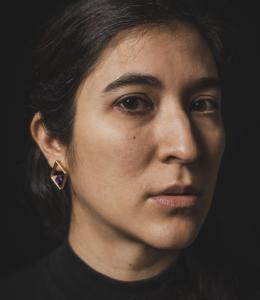
Dr Stephanie Lamprea
Digital Research Postdoctoral Fellow, January - June 2025
Home Institution: Royal Conservatoire of Scotland
Colombian-American soprano Stephanie Lamprea is an architect of new sounds and expressions as a performer, composer, and multidisciplinary artist, specializing in contemporary classical repertoire. Trained as an operatic coloratura, she uses her voice as a mechanism of avant-garde performance art, creating “maniacal shifts of vocal production and character… like an icepick through the skull” (Jason Eckardt). She has performed as a soloist at Roulette Intermedium (New York City), Constellation Chicago, Sound Scotland, Kings Place (London), Southbank Centre (London), the Huddersfield Contemporary Music Festival, the National Concert Hall (Dublin), the Centre for Contemporary Art (Glasgow), the Hidden Door Festival (Edinburgh), and the Casa da Música (Porto). She has collaborated with leading new music ensembles and bands including the Riot Ensemble, International Contemporary Ensemble, the City of London Sinfonia, Sō Percussion, and Post Coal Prom Queen. An established multidisciplinary artist, Stephanie has collaborated as a soprano and composer with contemporary artist Jesse Jones to co-create Mirror Martyr Mirror Moon, a film installation presented at the Ikon Gallery in Birmingham in partnership with the National Gallery in London. Mirror Martyr Mirror Moon received a five-star rating from the Observer, noting the "mesmerising film... The sound (and vision) is stunning, harrowing, agonising, sonorous and then garbled, stoppered, and running, as it seems, backwards." Stephanie has collaborated with video artist and photographer Oana Stanciu to create Anthropocenic Garden, a multidisciplinary exhibition for film, music, and dance, commissioned by and presented at the Hidden Door Festival. She has also collaborated with author and activist Jessica Gaitán Johannesson and sound artist Alistair MacDonald to co-create Soroche, a work for music, spoken voice, and film, commissioned by and presented at the Edinburgh Futures Institute. A prolific recording artist, Stephanie released albums Quaking Aspen, Georges Aperghis' 14 Récitations, and Don't Add to Heartache, to international critical acclaim. Quaking Aspen was hailed by PopMatters.com as "a bold artistic statement that’s exciting and innovative... a magical, intense, and deeply satisfying journey." 14 Récitations was described as a "tour-de-force... sportive vocal adventure of impressive proportions," (Concerti.de), "performance art of the highest caliber," (PopMatters.com), and a record in which "virtuosity is complemented by total commitment and vivid imagination." (Bandcamp.com) Don't Add to Heartache was celebrated as "an impassioned exploration of sound, space, and the relationship between nature and humanity... a fiercely inventive body of work that urges listeners to consider their relationship with nature in an increasingly artificial world." Stephanie completed her doctorate at the Royal Conservatoire of Scotland. She has taught and performed in residency for universities across the United States and Europe including the University of California at Davis, Temple University, the Royal Birmingham Conservatoire, the University of St Andrews, the Royal Conservatoire of Scotland, and the Graduate Center at the City University of New York. She has presented her artistic research for the European Platform for Artistic Research in Music (London), the Xperimus Conference (Porto), and Performance Research Ireland, and she was a featured TEDx Speaker for TEDxWaltham: Going Places. http://www.stephanielamprea.com/
Project title: A Feminist Digital Voice in Electroacoustic Music and Interdisciplinary Performance Art
Electroacoustic music has expanded the ways in which the voice can be shared, manipulated, transformed, and received. It has revealed a materiality of voice and body that can be found within technology, through which we can recontextualise the relationships, as Miriama Young notes, ‘between bodies and machines, between liveness and reproduction, between authenticity and mediation, between inscription and bodily absence…’ This embodiment of voice through the machine, however, does not address the pre-existing patriarchal associations of voice and body with gender. When not addressed, these associations become amplified in performance art with the addition of technology and sound design. Audio production has emphasised this patriarchal order in, for example, the design of early radio equipment which implemented frequency ranges primarily suitable for male voices, the reinforcement and disentangling of gender bias in AI assistant technology, the militaristic vernacular used in electronic music production, and the exclusion of female artists in the modern technological canon.
These scenarios necessitate an interdisciplinary and feminist approach to the digital voice, bearing two questions:
• What is the feminist digital voice, and what is its significance in the present day?
• How does one create feminist art with technology that is androcentric?
As machine-learning materials are utilised in electroacoustic and interdisciplinary works, it is pertinent to embark on feminist research of this technology and art-making to preserve, develop, and safeguard the spoken, sung, and signed female voice in a post-humanistic age. Through new practice-based research, Dr. Lamprea develops two postdoctoral projects: a live concert performance for voice, live electronics, wearable performance technology, and integrated British Sign Language, and an interdisciplinary video installation. These projects are rooted in several theoretical models including queer voice theory, feminist new materialism and posthuman feminism, feminist ethnography, D/deaf musicology and signed voice, and voice-body-machine entanglement.
